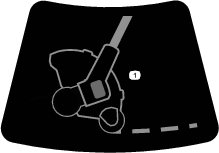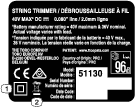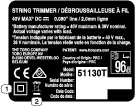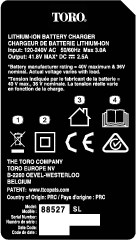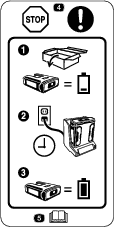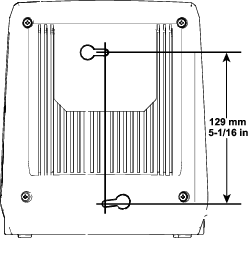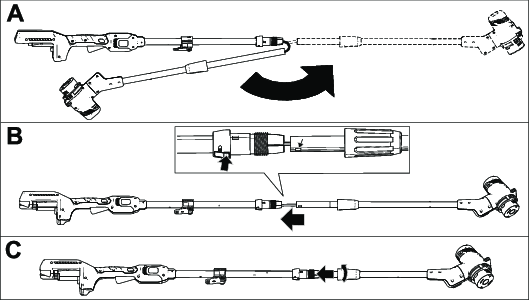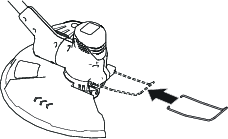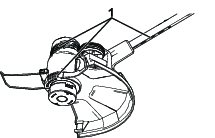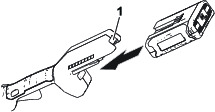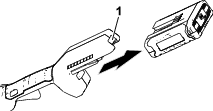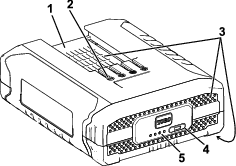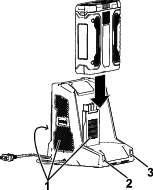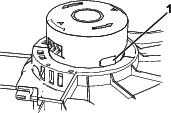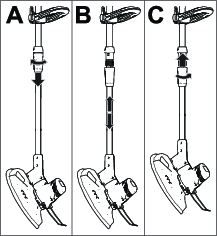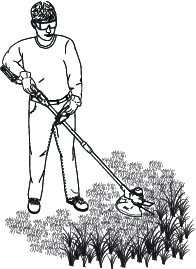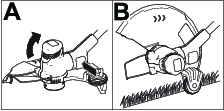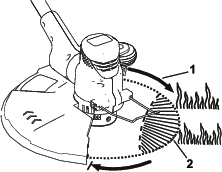Maintenance
After each use of the trimmer, complete the following:
-
Remove the battery from the trimmer.
-
Wipe the trimmer clean with a damp cloth. Do not hose the trimmer down or submerge it in water.
Caution
The line cutoff blade on the deflector is sharp and can cut you.
Do not use your hands to clean the deflector shield and blade.
-
Wipe or scrape clean the cutting head area any time there is an accumulation of debris.
-
Check and tighten all fasteners. If any part is damaged or lost, repair or replace it.
-
Brush debris away from air intake vents and exhaust on motor housing to prevent the motor from overheating.
Replacing the Spool
Use only 2 mm (0.080 inch) diameter monofilament string. Use the original manufacturer’s replacement string for best performance (Toro Part No. 88545TE).
Important: Using a larger diameter string causes the motor to overheat and fail.
-
Remove the battery.
-
Push in the tabs on the side of the spool retaining cover (Figure 17).
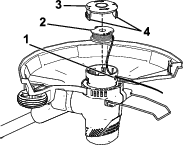
-
Pull the spool retaining cover up to remove it and remove the spool.
-
Install the new spool so that the string aligns with the eyelet in the string head. Thread the string into the eyelet.
-
Verify that the end of the string extends approximately 152 mm (6 inches) beyond the slot.
-
Pull the string extending from the string head so that the string releases from the slot in the spool.
-
Install the spool retainer by pressing the tabs into the slots and pushing down until the spool retainer clicks into place.
Replacing the String
-
Remove the battery.
-
Remove the spool; refer to Replacing the Spool.
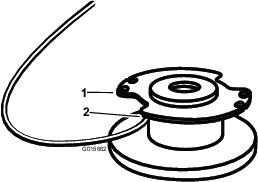
Note: Remove any old string remaining on the spool.
-
The spool accepts approximately 3.9 m (13 ft) of string. Use only 2 mm (0.080 inch) diameter monofilament string.
Note: Do not use any other gauge or type of string, as this could damage the trimmer.
-
Insert the string into the anchor hole (Figure 19). Wind the string onto the spool in the direction shown by the arrows on the spool.
-
Place the string in the slot on the upper spool flange, leaving about 152 mm (6 inches) extended beyond the slot.
Note: Do not overfill. After winding the string, there should be at least 6 mm (1/4 inch) between the wound string and the outside edge of the spool.
-
Replace the spool and the spool retainer; refer to Replacing the Spool.
Storage
Important: Store the tool, battery pack, and charger only in temperatures that are within the appropriate range; refer to Specifications.
Important: If you are storing the tool for a year or longer, remove the battery pack from the tool and charge the battery pack until 2 or 3 LED indicators turn blue on the battery. Do not store a fully charged or fully depleted battery. When you are ready to use the tool again, charge the battery pack until the left indicator light turns green on the charger or all 4 LED indicators turn blue on the battery.
-
Disconnect the product from the power supply (i.e., remove the plug from the power supply or the battery pack) and check for damage after use.
-
Clean all foreign material from the product.
-
When not in use, store the tool, battery pack, and battery charger out of the reach of children.
-
Keep the tool, battery pack, and battery charger away from corrosive agents, such as garden chemicals and de-icing salts.
-
To reduce the risk of serious personal injury, do not store the battery pack outside or in vehicles.
-
Store the tool, battery pack, and battery charger in an enclosed clean, dry area.
Preparing the Battery Pack for Recycling
Important: Upon removal, cover the terminals of the battery pack with heavy-duty adhesive tape. Do not attempt to destroy or disassemble the battery pack or remove any of its components. Recycle or properly dispose of lithium-ion battery packs at a battery recycling facility.
 |
For more information on recycling lithium-ion battery packs and to locate the battery recycling facility closest to you, visit www.Call2Recycle.org (US and Canada only). If you are located outside of the US and Canada, please contact your authorized Toro distributor. |

